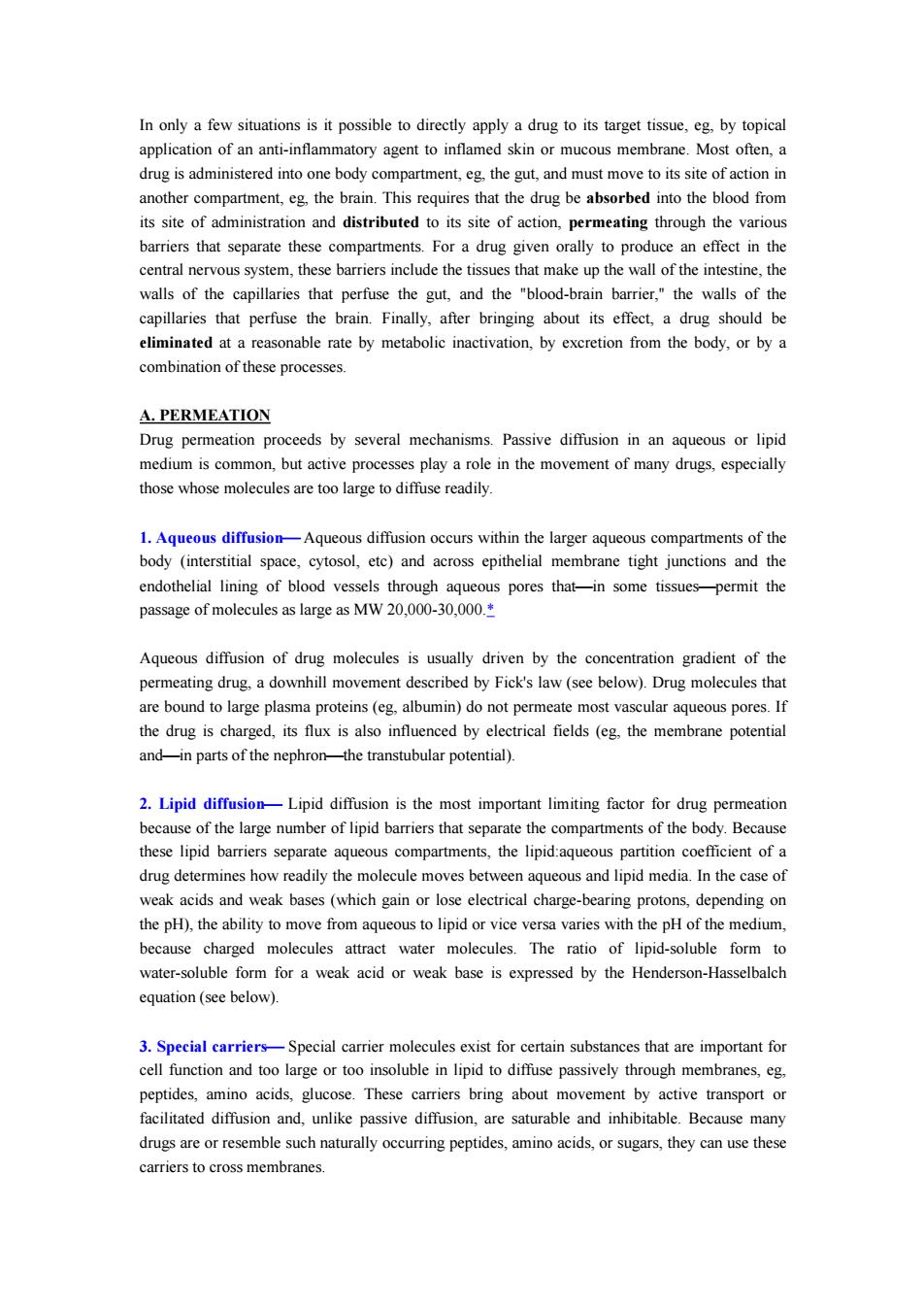正在加载图片...

In only a few situations is it possible to directly apply a drug to its target tissue,eg,by topical application of an anti-inflammatory agent to inflamed skin or mucous membrane.Most often,a drug is administered into one body compartment,eg,the gut,and must move to its site of action in another compartment,eg,the brain.This requires that the drug be absorbed into the blood from its site of administration and distributed to its site of action,permeating through the various barriers that separate these compartments.For a drug given orally to produce an effect in the central nervous system,these barriers include the tissues that make up the wall of the intestine,the walls of the capillaries that perfuse the gut,and the "blood-brain barrier,"the walls of the capillaries that perfuse the brain.Finally,after bringing about its effect,a drug should be eliminated at a reasonable rate by metabolic inactivation,by excretion from the body,or by a combination of these processes. A.PERMEATION Drug permeation proceeds by several mechanisms.Passive diffusion in an aqueous or lipid medium is common,but active processes play a role in the movement of many drugs,especially those whose molecules are too large to diffuse readily. 1.Aqueous diffusion-Aqueous diffusion occurs within the larger aqueous compartments of the body (interstitial space,cytosol,etc)and across epithelial membrane tight junctions and the endothelial lining of blood vessels through aqueous pores that-in some tissues-permit the passage of molecules as large as MW 20,000-30,000.* Aqueous diffusion of drug molecules is usually driven by the concentration gradient of the permeating drug,a downhill movement described by Fick's law(see below).Drug molecules that are bound to large plasma proteins(eg,albumin)do not permeate most vascular aqueous pores.If the drug is charged,its flux is also influenced by electrical fields (eg,the membrane potential and-in parts of the nephron-the transtubular potential). 2.Lipid diffusion-Lipid diffusion is the most important limiting factor for drug permeation because of the large number of lipid barriers that separate the compartments of the body.Because these lipid barriers separate aqueous compartments,the lipid:aqueous partition coefficient of a drug determines how readily the molecule moves between aqueous and lipid media.In the case of weak acids and weak bases(which gain or lose electrical charge-bearing protons,depending on the pH),the ability to move from aqueous to lipid or vice versa varies with the pH of the medium, because charged molecules attract water molecules.The ratio of lipid-soluble form to water-soluble form for a weak acid or weak base is expressed by the Henderson-Hasselbalch equation (see below). 3.Special carriers-Special carrier molecules exist for certain substances that are important for cell function and too large or too insoluble in lipid to diffuse passively through membranes,eg, peptides,amino acids,glucose.These carriers bring about movement by active transport or facilitated diffusion and,unlike passive diffusion,are saturable and inhibitable.Because many drugs are or resemble such naturally occurring peptides,amino acids,or sugars,they can use these carriers to cross membranes.In only a few situations is it possible to directly apply a drug to its target tissue, eg, by topical application of an anti-inflammatory agent to inflamed skin or mucous membrane. Most often, a drug is administered into one body compartment, eg, the gut, and must move to its site of action in another compartment, eg, the brain. This requires that the drug be absorbed into the blood from its site of administration and distributed to its site of action, permeating through the various barriers that separate these compartments. For a drug given orally to produce an effect in the central nervous system, these barriers include the tissues that make up the wall of the intestine, the walls of the capillaries that perfuse the gut, and the "blood-brain barrier," the walls of the capillaries that perfuse the brain. Finally, after bringing about its effect, a drug should be eliminated at a reasonable rate by metabolic inactivation, by excretion from the body, or by a combination of these processes. A. PERMEATION Drug permeation proceeds by several mechanisms. Passive diffusion in an aqueous or lipid medium is common, but active processes play a role in the movement of many drugs, especially those whose molecules are too large to diffuse readily. 1. Aqueous diffusion Aqueous diffusion occurs within the larger aqueous compartments of the body (interstitial space, cytosol, etc) and across epithelial membrane tight junctions and the endothelial lining of blood vessels through aqueous pores thatin some tissuespermit the passage of molecules as large as MW 20,000-30,000.* Aqueous diffusion of drug molecules is usually driven by the concentration gradient of the permeating drug, a downhill movement described by Fick's law (see below). Drug molecules that are bound to large plasma proteins (eg, albumin) do not permeate most vascular aqueous pores. If the drug is charged, its flux is also influenced by electrical fields (eg, the membrane potential andin parts of the nephronthe transtubular potential). 2. Lipid diffusion Lipid diffusion is the most important limiting factor for drug permeation because of the large number of lipid barriers that separate the compartments of the body. Because these lipid barriers separate aqueous compartments, the lipid:aqueous partition coefficient of a drug determines how readily the molecule moves between aqueous and lipid media. In the case of weak acids and weak bases (which gain or lose electrical charge-bearing protons, depending on the pH), the ability to move from aqueous to lipid or vice versa varies with the pH of the medium, because charged molecules attract water molecules. The ratio of lipid-soluble form to water-soluble form for a weak acid or weak base is expressed by the Henderson-Hasselbalch equation (see below). 3. Special carriers Special carrier molecules exist for certain substances that are important for cell function and too large or too insoluble in lipid to diffuse passively through membranes, eg, peptides, amino acids, glucose. These carriers bring about movement by active transport or facilitated diffusion and, unlike passive diffusion, are saturable and inhibitable. Because many drugs are or resemble such naturally occurring peptides, amino acids, or sugars, they can use these carriers to cross membranes